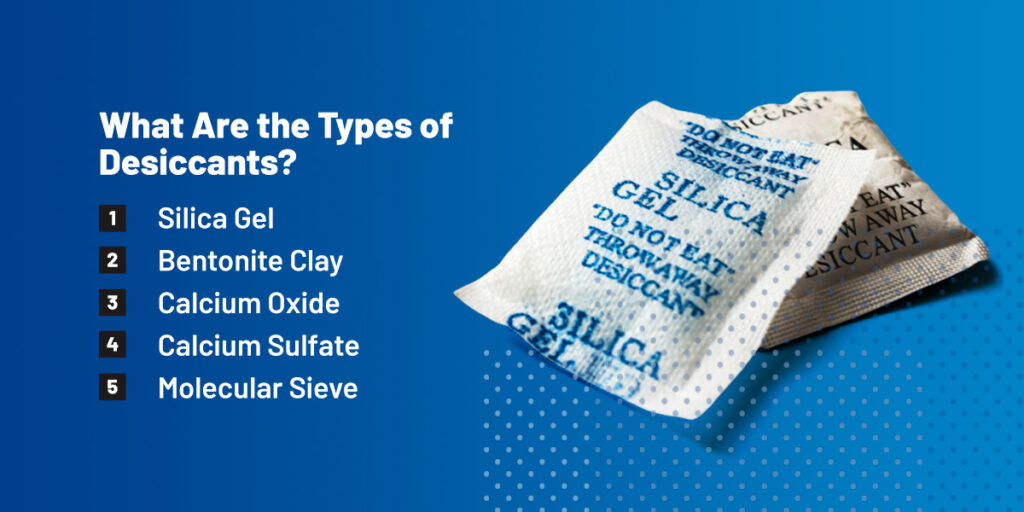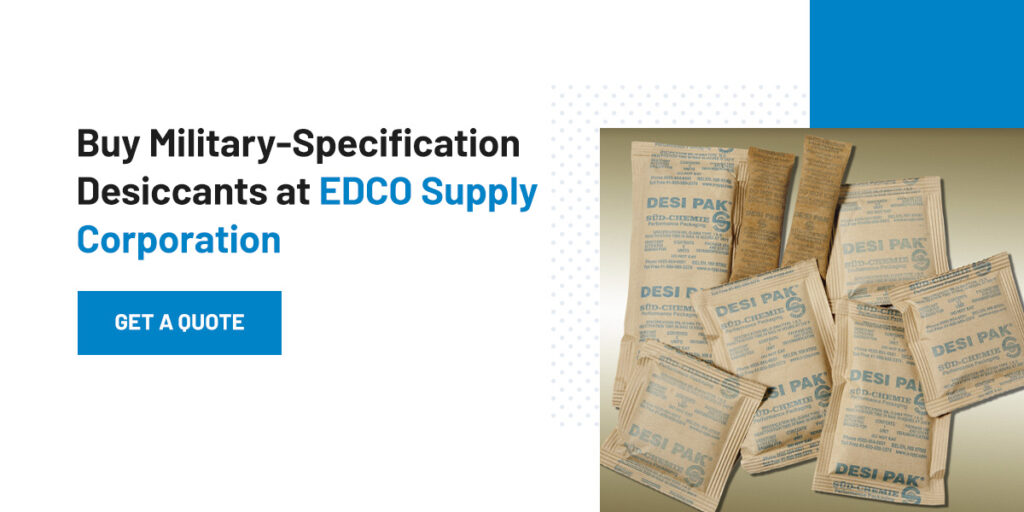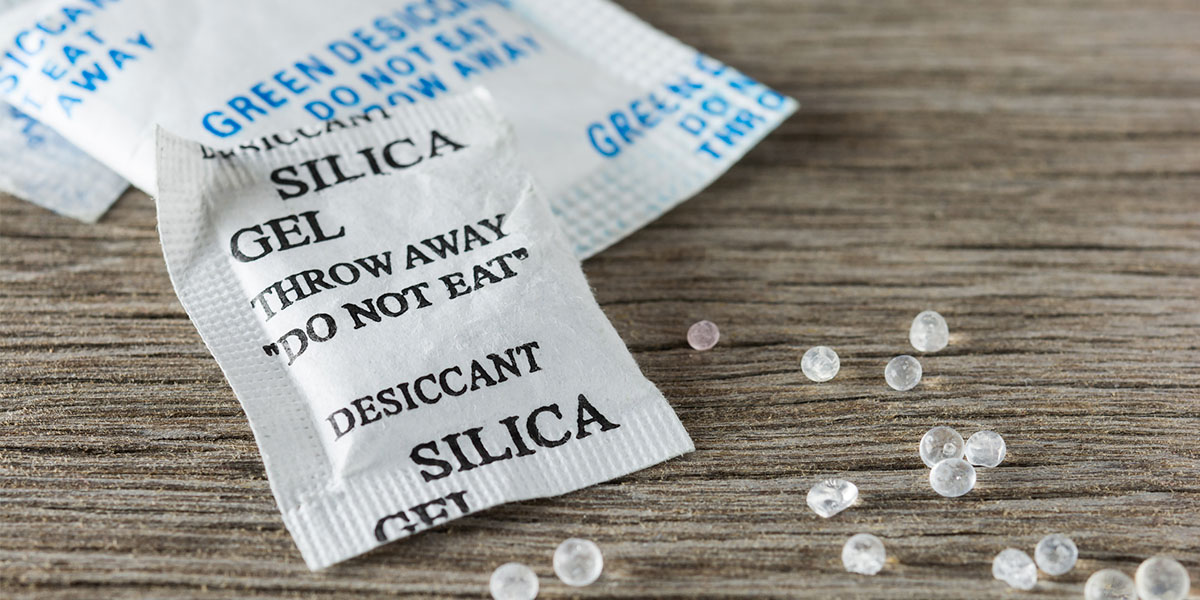Protective packaging is crucial to ensuring the safety and quality of products in various industries, from the military to consumer goods and apparel. Several packaging methods and strategies protect products from different types of damage, including moisture.
One of the most common types of protective packaging is desiccant packets. Desiccant packs are filled with substances that remove moisture from closed environments. These anti-moisture packets protect food, electronics and apparel from moisture damage during transport, storage and while they are being used.
What Are Desiccants?
Desiccants are hygroscopic substances that attract and absorb moisture from the surrounding air to maintain a state of dryness. These materials remove most of the humidity to ensure an environment remains dry. Water is eliminated in two ways using desiccants — physical and chemical.
Physical desiccation is when desiccants absorb moisture directly, while chemical desiccation uses chemical reactions to remove moisture. Both methods are highly effective and are used in several industries during manufacturing, packaging and shipping. Physical desiccation is the most commonly used form of desiccation.
Desiccants are vital to keeping packages dry during transport and storage. Any moisture trapped in sealed environments such as containers and product packaging can build up, resulting in dampness that can cause significant damage to products. In addition to absorbing moisture, desiccants can also absorb odors and other chemicals to ensure the safety and quality of products.
Electronics and other metal items may start to corrode over time, while bacteria, mold and fungus can grow on fabrics and in food. Cosmetics and medication can also be affected, with moisture affecting the efficacy of these products. Food desiccant packets are usually used to keep dehydrated foods dry.
Using desiccants can help prevent all of this potential damage, ensuring products undergo safe transportation and storage. If done properly, you’re also able to reuse and reutilize your existing desiccant packs.
What Are the Benefits of Using Desiccant Packs?
The major benefit of desiccants is that they are perfect for protecting products from moisture. They can absorb humidity, moisture, odors, and chemicals to really protect your products. Moisture can cause significant damage to products, particularly expensive products like electronics and semiconductors. Also, high levels of humidity cause the growth of fungus, mildew, and mold. This can really be gross for your customers to deal with, particularly if they are receiving food products. Keep that in mind when choosing the ideal packaging for your products!
Another example of a business that benefits from desiccant packs is pharmaceutical companies, which use these packs to keep their medicine and pills safe from moisture. Leather goods companies also use desiccant packs to keep their products safe from harm. Even the aerospace industry uses desiccant packs as a means to protect missile components.
Finally, an additional major benefit of desiccant packs is that they are reusable. These packs can last a very long time and can be repurposed in a variety of different ways. For example, after you are done using them to protect a certain product, you can use them to save a cell phone from water damage or to keep important documents safe. There really are so many uses for desiccant packs that your customer will be very happy to receive them along with your actual products.

What Are the Types of Desiccants?
There are different types of desiccants, the most common and well-known of which is silica gel. These drying packets are commonly found in medication bottles, shoe boxes and food packages. Other desiccants include bentonite clay, calcium oxide, calcium sulfate and molecular sieves.
Here is a summary of the different desiccants.
1. Silica Gel
Silica gel is a desiccant made from silicon dioxide, a naturally occurring mineral. The silicon dioxide is purified and then processed into beads or granules. It is one of the most commonly used desiccants because it can absorb water in temperatures up to 220 degrees Fahrenheit and remains the same size once it has absorbed moisture.
In addition, silica gel can absorb other substances, including ammonia, alcohol, aromatics and paraffin. It has a strong affinity for water and may “release” other substances to absorb more water.
2. Bentonite Clay
Made from a naturally occurring mineral called calcium aluminosilicate, bentonite clay is a chemically inert and non-corrosive desiccant. As a result, it will not react to the chemicals in or around products or cause corrosion.
Desiccant clay is more effective in temperatures of up to 120 degrees Fahrenheit and can absorb nearly 30% of its weight in moisture. Like silica gel, bentonite clay stays the same size and shape once it has absorbed water.
Bentonite clay is one of the least expensive desiccants, making it a cost-effective ingredient to add to desiccant packages. If you are using clay as your primary desiccant, it is essential to consider the temperatures your products may experience during transit.
3. Calcium Oxide
Also known as quicklime, calcium oxide is calcinated or re-calcinated lime. The calcination process removes any volatile substances, such as carbon dioxide, to make it safer. Calcium oxide can absorb a significant amount of water in low humidity levels compared to other desiccants.
Quicklime absorbs water slowly, so it can take a few days to remove all the moisture altogether. Unlike bentonite clay and silica gel, calcium oxide swells as it absorbs water. Calcium oxide is usually limited to use in dehydrated foods.
4. Calcium Sulfate
Calcium sulfate is made by dehydrating gypsum. It is a non-corrosive, non-toxic and non-disintegrating desiccant that is chemically stable. It can also withstand higher temperatures and continue to absorb water, making it well-suited for use in laboratories.
However, calcium sulfate can only absorb up to 10% of its weight in moisture. It also has a limited life span and regenerative properties, so it is less widely used in desiccant packages.
5. Molecular Sieve
Molecular sieves are synthetic crystalline aluminosilicates designed to absorb molecules of a specific size. The pore size of the sieve can be designed to attract and retain particular substances based on their molecule size. As a result, molecular sieves are one of the most effective desiccants that can absorb water from other desiccants, including silica gel.
Molecular sieves are mainly used for reagents and biochemical packaging, as they can be tailored to specific molecules. These are the most expensive desiccants.
What Is a Military-Specification Desiccant?
Military-specification desiccants, or MIL-D-3464E, are substances that meet the strict requirements of the United States military for desiccant performance and packaging. As military desiccants have to meet stringent requirements and undergo strict testing, they are the preferred desiccation method for several industries. Military desiccants are usually made with silica gel or bentonite clay.
Military-specification desiccants are measured in units. Each unit is the equivalent of one ounce. The number of units you use depends on the humidity levels and the amount of moisture that must be absorbed. A military unit is based on how much desiccant is needed to absorb:
- 3 grams of water in 20% relative humidity in temperatures up to 25 degrees Celsius (77 degrees Fahrenheit)
- 6 grams of water at 40% relative humidity in temperatures up to 25 degrees Celsius (77 degrees Fahrenheit)
Types of Military Desiccant Classifications
There are three desiccant classifications under MIL-D-3464E:
- Type I: Meet the military specifications for absorption rate, reactivation, dusting and durability.
- Type II: Meet the same specifications as Type I but have a tighter dusting specification, making them “low dust.”
- Type III: Meet the specifications for Type I bags and are resistant to hot water.
All MIL-D-3464E bags are required to have specific information on them to be military-specification desiccants. MIL-D-3463E bags must feature the following details:
- Nomenclature — desiccant, activated, bagged for package use or static dehumidification
- Military specification code
- Bag type
- Manufacturer designation, name and address
- Unit contents
- Reactivation temperature in the bag
- Reactivation time
- Desiccant reuse and reactivation

Buy Military-Specification Desiccants at EDCO Supply Corporation
EDCO Supply Corporation supplies a range of Type I and II desiccant drying packets for several industries. Our military-specification desiccant bags absorb moisture, odors and chemicals for numerous products, including electronics, food cartons and machinery.
Browse our range of military-specification desiccant packets or request a quote today.



